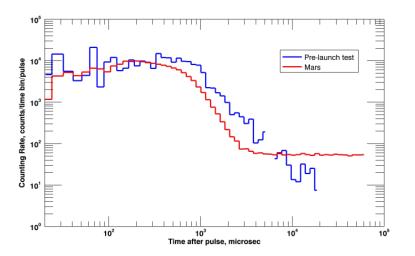
|
Curiosity Blasts Ground with Neutrons
- Click the image above for a larger view
- Full-Res JPEG (4096 x 2523) (359.9 kB)
- Full-Res TIFF (4096 x 2523) (31.0 MB)
Caption:
NASA's Curiosity rover pinged the ground with neutrons for the first time, a process called active neutron sounding, on August 17, 2012. The instrument involved, called the Dynamic Albedo of Neutrons, or DAN, measures the amount of hydrogen -- an indicator of water -- in soil by observing the degree to which neutrons are scattered.
The red time profile shows neutrons that were emitted from the ground below Curiosity after the instrument's pulsing neutron generator hit the ground with pulses of neutrons having energies of 14 megaelectron volts. The blue line shows a pre-launch test of the instrument for comparison.
These data provide information about the content of water at the Curiosity landing site, and show that the instrument is in perfect shape for the first use of the neutron sounding technique in its interplanetary exploration. Later, when Curiosity is on the move, variations of the height and duration of this profile will indicate changes in the water content of the soil down to about 3.3 feet (one meter) below the surface.
The most likely hydrogen in the ground of Gale Crater is in hydrated minerals. These are minerals with water molecules or hydroxyl ions bound into the crystalline structure of the mineral. They can tenaciously retain water from a wetter past after all free water has gone.
Cataloging Keywords:
| Name | Value | Additional Values |
|---|---|---|
| Target | Mars | |
| System | ||
| Target Type | Planet | |
| Mission | Mars Science Laboratory (MSL) | |
| Instrument Host | Curiosity Rover | Dynamic Albedo of Neutrons (DAN) |
| Host Type | Rover | |
| Instrument | Dynamic Albedo of Neutrons (DAN) | |
| Detector | ||
| Extra Keywords | Color, Crater, Water | |
| Acquisition Date | ||
| Release Date | 2012-08-21 | |
| Date in Caption | 2012-08-17 | |
| Image Credit | NASA/JPL-Caltech/Russian Space Research Institute | |
| Source | photojournal.jpl.nasa.gov/catalog/PIA16084 | |
| Identifier | PIA16084 | |
